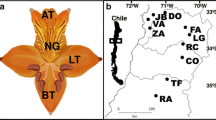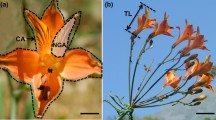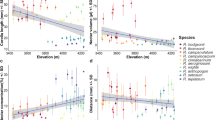Abstract
Globally, bird-pollinated plants can be separated into two groups, one consisting of species pollinated by specialist nectarivores, and the other of plants pollinated by occasional nectarivores. There are marked differences in nectar properties among the two groups, implying that there has been pollinator-mediated selection on these traits. This raises the possibility that variation in bird assemblages among populations of a plant species could lead to the evolution of intraspecific variation in floral traits. We examined this hypothesis in Kniphofia linearifolia, a common and widespread plant in southern Africa. Although bees are common visitors to flowers of this species, exclusion of birds from inflorescences led to significant reductions in seed set, indicating that the species is primarily bird-pollinated. We showed that bird pollinator assemblages differ markedly between five different populations of K. linearifolia, and that variation in flower morphology and nectar properties between these populations are associated with the dominant guild of bird visitors at each population. We identified two distinct morphotypes, based on corolla length, nectar volume and nectar concentration, which reflect the bird assemblages found in each type. Further work is needed to establish if a natural geographic mosaic of bird assemblages are the ultimate cause of differentiation in floral traits in this species.





Similar content being viewed by others
References
Alexandersson R, Johnson SD (2002) Pollinator-mediated selection on flower-tube length in a hawkmoth-pollinated Gladiolus (Iridaceae). Proc R Soc Lond B 269:631–636
Anderson B, Johnson SD (2009) Geographical covariation and local convergence of flower depth in a guild of fly-pollinated plants. New Phytol 182:533–540
Baker I, Baker HG (1982) Some chemical constituents of floral nectars of Erythrina in relation to pollinators and systematics. Allertonia 3:25–37
Botes C, Johnson SD, Cowling RM (2008) Coexistence of succulent tree aloes: partitioning of bird pollinators by floral traits and flowering phenology. Oikos 117:875–882
Botes C, Johnson SD, Cowling RM (2009) The birds and the bees: using selective exclusion to identify effective pollinators of African Aloes. Int J Plant Sci 170:151–156
Boyd A (2002) Morphological analysis of Sky Island populations of Macromeria viridiflora (Boraginaceae). Syst Bot 27:116–126
Boyd A (2004) Breeding system of Macromeria viridiflora (Boraginaceae) and geographic variation in pollinator assemblages. Am J Bot 91:1809–1813
Brown M, Downs CT, Johnson SD (2009) Pollination of the red hot poker Kniphofia caulescens by short-billed opportunistic avian nectarivores. S Afr J Bot 75:707–712
Brown M, Downs CT, Johnson SD (2010) Pollination of the red-hot poker Kniphofia laxiflora (Asphodelaceae) by sunbirds. S Afr J Bot 76:460–464
Bruneau A (1997) Evolution and homology of bird pollination syndromes in Erythrina (Leguminosae). Am J Bot 84:54–71
Campbell DR, Waser NM, Price MV (1996) Mechanisms of hummingbird-mediated selection for flower width in Ipomopsis aggregata. Ecology 77:1463–1472
Codd LE (1968) The South African species of Kniphofia. Bothalia 9:367–513
Cruden RW (1997) Implications of evolutionary theory applied to pollination ecology. Acta Horta 437:27–51
Cruden RW, Toledo VM (1977) Oriole pollination of Erythrina brevifolia (Leguminosae): evidence for a polytypic view of ornithophily. Plant Syst Evol 126:393–403
Fenster CB, Armbruster WS, Wilson P, Dudash MR, Thomson JD (2004) Pollination syndromes and floral specialization. Annu Rev Ecol Evol Syst 35:375–403
Ford CM, Johnson SD (2008) Floral traits, pollinators and breeding systems in Syncolostemon (Lamiaceae). Plant Syst Evol 275:257–264
Galen C (1989) Measuring pollinator-mediated selection on morphometric floral traits: bumblebees and the alpine sky pilot, Polemonium viscosum. Evolution 43:882–890
Galen C (1996) Rates of floral evolution: adaptation to bumblebee pollination in an alpine wildflower, Polemonium viscosum. Evolution 50:120–125
Harder LD, Johnson SD (2009) Darwin’s beautiful contrivances: evolutionary and functional evidence for floral adaptation. New Phytol 183:530–545
Hargreaves AL, Johnson SD, Nol E (2004) Do floral syndromes predict specialization in plant pollination systems? An experimental test in an “ornithophilous” African Protea. Oecologia 140:295–301
Herrera J (2005) Flower size variation in Rosmarinus officinalis: individuals, populations and habitats. Ann Bot 95:431–437
Johnson SD (1996) Pollination, adaptation and speciation models in the Cape flora of South Africa. Taxon 45:59–66
Johnson SD (1997) Pollination ecotypes of Satyrium hallackii (Orchidaceae) in South Africa. Bot J Linn Soc 123:225–235
Johnson SD (2004) An overview of plant–pollinator relationships in Southern Africa. Int J Trop Insect Sci 24:45–54
Johnson SD, Nicolson SW (2008) Evolutionary associations between nectar properties and specificity in bird pollination systems. Biol Lett 4:49–52
Johnson SD, Steiner KE (1997) Long-tongued fly pollination and evolution of floral spur length in the Disa draconis complex (Orchidaceae). Evolution 51:45–53
Johnson SD, Steiner KE (2000) Generalization versus specialization in plant pollination systems. Trends Ecol Evol 15:140–143
Johnson SD, Steiner KE (2003) Specialized pollination systems in southern Africa. S Afr J Sci 99:345–348
Johnson SD, Hargreaves AL, Brown M (2006) Dark, bitter-tasting nectar functions as a filter of flower visitors in a bird-pollinated plant. Ecology 87:2709–2716
Johnston MO (1991) Natural selection on floral traits in two species of Lobelia with different pollinators. Evolution 45:1468–1479
Kephart S, Theiss K (2003) Pollinator-mediated isolation in sympatric milkweeds (Asclepias): do floral morphology and insect behavior influence species boundaries? New Phytol 161:265–277
Nattero J, Cocucci AA (2007) Geographical variation in floral traits of the tree tobacco in relation to its hummingbird pollinator fauna. Biol J Linn Soc 90:657–667
Ramdhani S, Barker NP, Baijnath H (2006) Phylogenetics of the genus Kniphofia Moench (Asphodelaceae). In: Ghazanfar SA, Beentje HJ (eds) Taxonomy and ecology of African plants, their conservation and sustainable use. Royal Botanic Gardens, Kew, pp 559–573
Ramdhani S, Barker NP, Baijnath H (2008) Exploring the Afromontane centre of endemism: Kniphofia Moench (Asphodelaceae) as a floristic indicator. J Biogeogr 35:2258–2273
Robertson JL, Wyatt R (1990) Evidence for pollination ecotypes in the yellow-fringed orchid, Platanthera ciliaris. Evolution 44:121–133
Symes CT, Nicolson SW (2008) Production of copious dilute nectar in the bird-pollinated African succulent Aloe marlothii (Asphodelaceae). S Afr J Bot 74:598–605
Symes CT, Human H, Nicolson SW (2009) Appearances can be deceiving: pollination in two sympatric winter-flowering Aloe species. S Afr J Bot 75:668–674
Wilson A, Ward D, Brown M, Johnson SD (2009) Seed production in a threatened Aloe is not affected by bird exclusion or population size. Plant Ecol 203:173–182
Acknowledgments
We thank Stuart Maclean and the late Prof. Steven Piper for discussions about the project. Kelly Brown assisted with field work. Ezemvelo KZN Wildlife granted permission (project registration number NA/20091/02) to work within the protected area of Sani Pass. We are grateful to Mark Norris-Rogers for producing the map in Fig 1.
Author information
Authors and Affiliations
Corresponding author
Rights and permissions
About this article
Cite this article
Brown, M., Downs, C.T. & Johnson, S.D. Covariation of flower traits and bird pollinator assemblages among populations of Kniphofia linearifolia (Asphodelaceae). Plant Syst Evol 294, 199–206 (2011). https://doi.org/10.1007/s00606-011-0443-1
Received:
Accepted:
Published:
Issue Date:
DOI: https://doi.org/10.1007/s00606-011-0443-1




